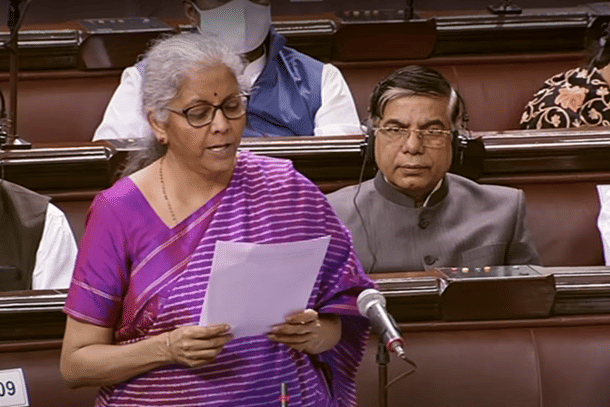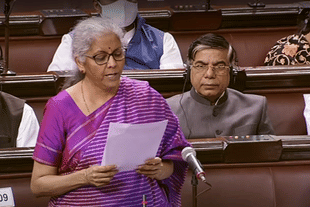News Brief
FM Sitharaman In Rajya Sabha: 3.1 Per Cent Deflator Feasible For FY23; GDP Growth Estimates Conservative
Swarajya Staff
Mar 31, 2022, 01:47 PM | Updated 01:46 PM IST
Save & read from anywhere!
Bookmark stories for easy access on any device or the Swarajya app.


The Finance Minister, Nirmala Sitharaman, speaking in the Rajya Sabha on Tuesday (29 March), said that the government believes inflation would come down and that a 3.1 per cent GDP deflator is feasible in 2022-23. She was responding to questions on the credibility of budget estimates in the Rajya Sabha.
She said that the GDP deflator, which is the difference between nominal and real GDP growth rate, has been 3.15 per cent over the past five years and the estimate for 2022-23 is close to the five-year estimate.
Sitharaman said that deflator is neither consumer inflation (Consumer Price Index - CPI) nor wholesale inflation (Wholesale Price Index - WPI) and that it has components of both.
She admitted that the wholesale inflation is much higher than the retail inflation, but reiterated that the government believes the wholesale inflation would shrink in 2022-23.
The Wholesale inflation in February was 13.11 per cent, while the retail inflation was 6.1 per cent during the month.
She was responding to Congress Rajya Sabha MP and former finance minister P Chidambaram's question on budget estimate of 11.1 per cent nominal GDP growth even as the Economic Survey puts the real GDP growth rate at 8-8.5 per cent. Chidambaram had, therefore, questioned the government's inflation (deflator) estimates in 2022-23.
She stated that the Chief Economic Advisor, is part of the Ministry, but his report and assessments are normally his own. The Ministry keeps that report at an arm's distance.
The Finance Minister said that the Economic Survey is an independent report, and the budget estimates are based on advanced estimates released by the National Statistics Office (NSO). She hinted that there could be differences in the Economic Survey estimates and the Budget estimates.
Moreover, she stated that the GDP growth estimates for the next year are conservative. She highlighted with no doubt that Ukraine is a new factor. She said that the unprecedented hike in fuel prices is also a new challenge.
However, she submitted that the Ministry take a whole year's picture when making the Budget or when talking of the economy rather than reviewing it and reassessing it weekly or even monthly.
She stated that the fact and also insofar as the inflation issue is concerned, the WPI indices is in the deflator, has been very high in the current year compared to the CPI indices. She was hopeful that the WPI indices will shrink going forward, and the deflator, over the real economic growth, will be lower in the next financial year.
Additionally, she mentioned that the government and private sectors are partners in ushering development in the economy. Therefore, to set up private investments, the government has launched PLI schemes in 14 sectors, expected to add additional productive capacity of over Rs 30 lakh crore over next the five years.
Talking about the health sector she mentioned that the Cabinet, on 22 April 2020, approved significant investments in health sector. Rs 15,000 crore were allotted, and Rs 23,123 crore were again provided on 8 July 2021 for the phase II of health preparedness packages.
For the education of children, she stated that there's 'one class, one TV channel' program. She added that financial support to farmers belonging to SC/ST (in agro forestry) has been enhanced.
She said that from 2013 to 2022-23, actual utilisation of Health and Education Cess is estimated to be Rs 3.94 lakh crore as against collection of Rs 3.77 lakh crore. This cess is primarily funding centrally sponsored schemes in states.





